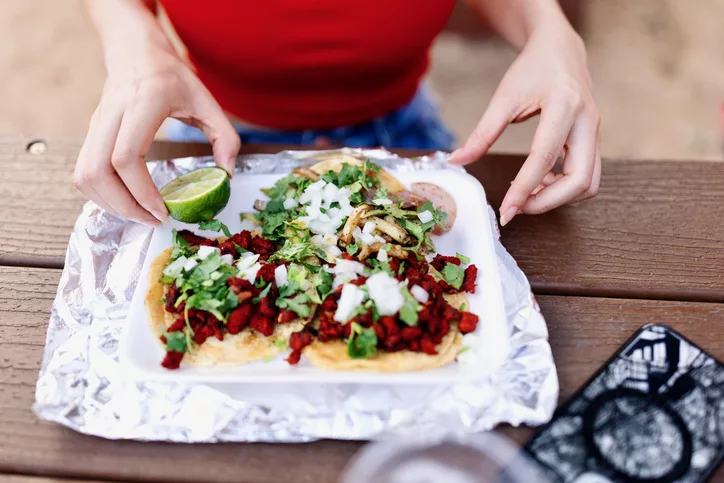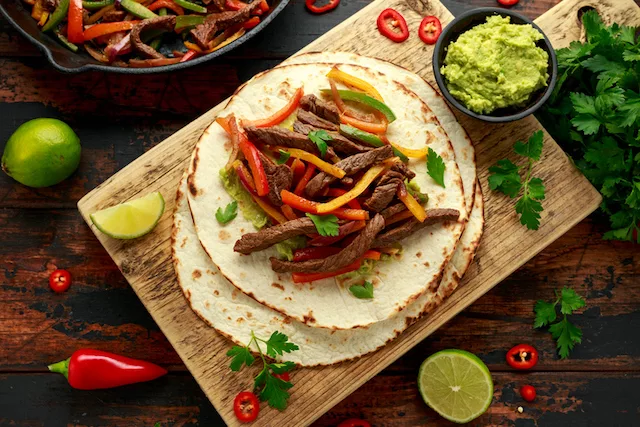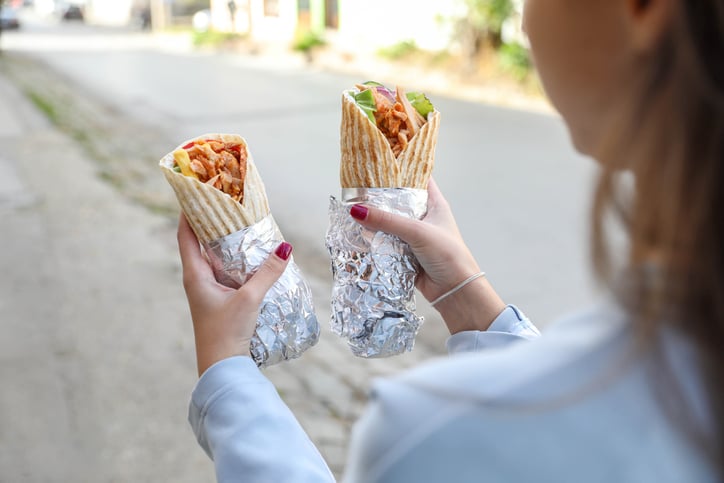Picture this: You’re in line with your date at Chipotle, preparing to step up to the ordering counter, and you freeze. While you drool over this menu, you suddenly remember that the last time you ate here, you devoured your delicious meal only to be plagued with uncomfortable bloating and gas for the rest of the night.
What should you do to prevent an untimely repeat of this experience? Let’s take a closer look at Chipotle nutrition for preventing bloat. Here are some of the menu items to steer clear of and some better bets (and tips!) for enjoying a bloat-free evening.

Why Do Some Foods Cause Bloating?
We can all respond differently to foods and ingredients, which can include a variety of tummy troubles that aren’t always predictable. As annoying as it is, there is some scientific explanation.
First, the makeup of your gut microbiome — the community of microbes living throughout your digestive tract — can help explain why your friend can eat a pile of beans with no trouble while you’re left hunched over with gas pains 10 minutes later.
A diverse microbiome helps more efficiently break down various foods. A less diverse microbiome may struggle with certain foods, leading to bloating and gas production.
Furthermore, everyone’s gut microbiome has a unique composition that determines how effectively we can digest certain things. Some people may have more bacteria that are efficient at breaking down complex carbohydrates and reducing bloating, while others may not.
What Items are More Likely to Cause Bloating at Chipotle?
Generally speaking, bloating is often caused by foods that produce excess gas during digestion or those that are more difficult to digest.
Many of the foods that fit into these categories at Chipotle contain FODMAPs (Fermentable Oligosaccharides, Disaccharides, Monosaccharides, and Polyols) which are specific types of carbohydrates that are poorly absorbed in the small intestine and can cause digestive discomfort and bloating in some people.
When it comes to exploring Chipotle nutrition, some of the more likely gas-producing culprits include:
- High-fiber foods: While fiber is essential for digestion, foods that are very high in fiber, such as beans, lentils, and whole grains, can cause bloating if your body is not used to them.
- Dairy products: People who are lactose intolerant or have a sensitivity to lactose (a disaccharide) may experience bloating after consuming milk, cheese, yogurt, and other dairy products.
- Fatty foods: High-fat foods slow down digestion, which can cause bloating. This includes fried foods (like tortilla chips), fatty meats, and rich desserts.
- Onions and garlic: These contain fructans, which are oligosaccharides and a type of soluble fiber that can cause bloating in some people.
- Beans: Legumes like pinto and black beans are high in fiber and contain oligosaccharides, which can cause gas and bloating.
Healthy Chipotle Choices
1. Bowl with Rice
Bowls are a great way to pack in flavors but ditch the high-FODMAP tortilla, which contains wheat and therefore fructans. Both brown rice and white rice are considered low-FODMAP foods, making them generally suitable for people with sensitivities. However, brown rice is slightly higher in fiber than white rice. If you know you’re sensitive to brown rice or whole grains in general, you might go with white this time.
2. Grilled Chicken
Grilled chicken is a lean source of protein that is typically easy to digest. It doesn’t contain the complex carbohydrates or fibers that can cause fermentation and gas production in your gut. It’s also naturally low in FODMAPs and typically made with simple spices that are less likely to irritate the stomach than spicier options.
3. Sofritas
While sofritas are made from soybeans, part of the legume family, they contain less fiber than beans per serving. They are also lower in fat and may be more easily digested than animal proteins for some people.
4. Fajita Vegetables
Fajita vegetables at Chipotle consist mainly of sautéed bell peppers and onions, which are generally easy to digest when cooked. Cooking vegetables softens their fibers and reduces the amount of oligosaccharides in the onions, making them gentler on the digestive system. Fajita veggies are also lightly seasoned and low in calories and fat.


5. Black Beans
Black beans tend to have fewer oligosaccharides and less fiber compared to pinto beans, which may make them easier on the stomach.
6. Lettuce
Adding lettuce to your dish is a great way to add bulk with minimal fiber compared to other plant-based ingredients. Plus, lettuce is naturally low in FODMAPs, has a high water content, and is gentle on the digestive system.
7. Tomato Salsa (Pico)
Pico de gallo is typically low in FODMAPs, especially if you avoid the bits of onion. It has a high water content, is mildly seasoned, and is low in fat, making it a gentler choice on the stomach for many people.
8. Corn Salsa
Chipotle corn salsa is made with corn, tomatoes, onions, and cilantro. While onions can be high in FODMAPs, the corn in the salsa is generally well-tolerated and doesn’t trigger bloating. Corn also provides the bulk of the fiber in this salsa, which supports healthy digestion without being overpowering.
9. Guacamole
Avocados are rich in healthy monounsaturated fats, which are easier to digest than saturated fats found in animal products. While avocados do contain a moderate amount of FODMAPs, the serving size typically used in Chipotle’s guacamole is small enough not to cause issues.
10. Cheese
The shredded white cheese used at Chipotle is Monterey Jack, which is low in FODMAPs and contains less lactose compared to soft cheeses and other dairy products. Cheese also doesn’t provide any fiber so it doesn’t contribute to fermentation in the gut.
Other Tips to REduce Bloating at Chipotle
Now that you have an idea of how to navigate Chipotle nutrition when going bloat-less is your goal, here are a few other tips to help keep your tummy happy:
- Don’t go overboard: Even though there are plenty of low-FODMAP items on the menu, don’t take that as your cue to pile them on endlessly. Stick to moderation and increase the variety of easily digestible components instead, especially if you’re unsure how you might react to certain ingredients.
- Stay hydrated: Since carbonation can also trigger bloating in sensitive people, consider sipping on water while you eat instead. This can help support healthy digestion and prevent constipation and bloating.
- Slow down: Eating too quickly can cause bloating. This is a great opportunity to incorporate more mindfulness into your eating, slowing down and paying attention to how certain ingredients are making you feel. It can help to put your fork down between bites and take a sip of water.
- Take a bloat-relief supplement: Flatter Me™ has been clinically studied to relieve bloat in 30 minutes. This convenient supplement contains 18 full-spectrum digestive enzymes including bromelain, papain, amylase, and lactase to help break down all foods including carbs, fats, sugars, lactose, fibers, and protein for reduced bloating, improved digestion, and nutrient absorption.
The Takeaway
Bloating can happen at any time and for many reasons. It’s helpful to take note of whether certain types of ingredients at Chipotle (or elsewhere) are particularly irritating to your stomach. Try choosing moderate portions of easily digestible ingredients and avoid high-FODMAP items if you’re concerned about bloat.

